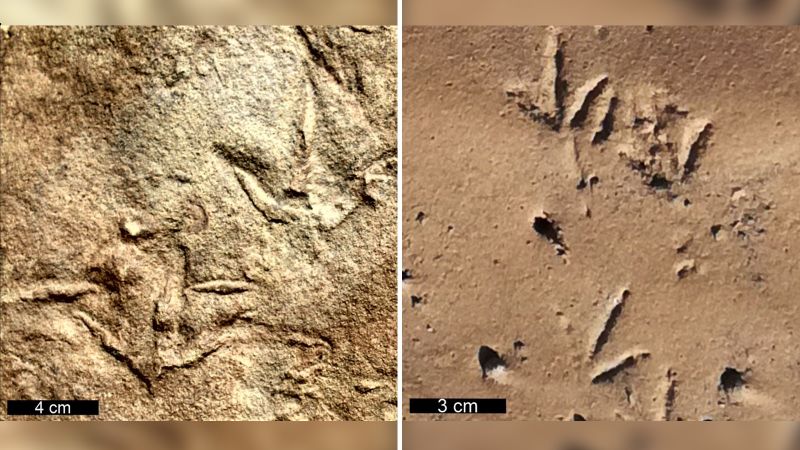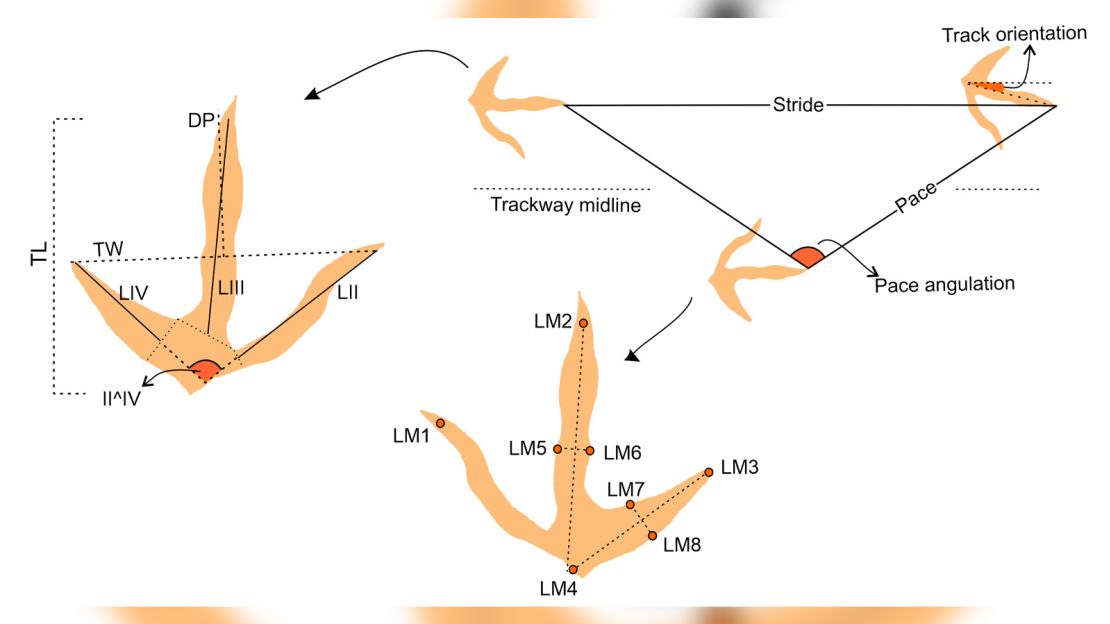
Join CNN’s Surprise Idea science publication. Explore the universe with news on fascinating discoveries, scientific advancements and more.
CNN
—
Three-toed fossil footprints that date again greater than 210 million years have been pressed into smooth mud by bipedal reptiles with ft like a fowl’s, a brand new evaluation of the tracks has revealed.
The footprints, discovered at a number of websites in southern Africa, have been just lately recognized because the oldest birdlike tracks ever discovered, previous the earliest recognized skeletal fossils of avians by about 60 million years.
“Given their age they have been probably made by dinosaurs,” stated Dr. Miengah Abrahams, a lecturer in geological sciences on the College of Cape City in South Africa. Abrahams is lead creator of the brand new research describing the tracks, revealed Tuesday within the journal PLOS One.
Theropods, together with Tyrannosaurus rex, have been a various group of bipedal meat-eaters with three-toed ft. However amongst these newly examined dinosaur tracks have been some that differed from typical theropod prints. The outliers had a shorter extension of the central digit, a a lot wider splay and “considerably narrower toes,” making them look extra just like the footprints of birds, Abrahams advised CNN in an e mail.
Nevertheless, as a result of the animals that made the tracks are unknown, their relationship to birds is unclear. The prints may symbolize a lacking clue about avian evolution, or they may belong to reptiles that aren’t near the avian lineage however independently advanced birdlike ft, the researchers reported.
The footprints have been found within the mid-Twentieth century and have been assigned the scientific title Trisauropodiscus by French paleontologist Paul Ellenberger. The title is an ichnogenus, which means that it describes a genus primarily based on hint fossils, or fossilized impressions that an animal left behind, slightly than fossils of its physique.
There are regarded as seven ichnospecies linked to Trisauropodiscus tracks, and for many years paleontologists argued over the avian affinity of the group. Some known as the tracks birdlike, however others weren’t so certain. Ellenberger could have muddied the waters by assigning many in a different way formed tracks to the ichnogenus, “and never all of them are birdlike,” Abrahams stated.
What’s extra, the form of a footprint can differ significantly, primarily based on what kind of fabric the animal stepped in. This could make it tough to pinpoint bodily options of extinct animals when fossilized tracks are the one clues that they left behind, stated Dr. Julia Clarke, a professor of vertebrate paleontology on the College of Texas at Austin, who was not concerned within the research.
“Footprints are this actually distinctive report,” Clarke advised CNN. “However there’s at all times going to be that zone of uncertainty, simply within the nature of the info that we’ve got.”
On the time that the Trisauropodiscus tracks have been stamped into mud, evolutionary variations have been booming in archosaurs — the traditional reptile group that features dinosaurs, pterosaurs and crocodilians — so it’s intriguing to search out proof of birdlike ft in an unknown member of this group, she added.
“The footprints will not be a direct match for any fossil animals recognized from this area and time interval. They might belong to different reptiles or cousins of dinosaurs that advanced birdlike ft,” Clarke stated. “It’s including to our understanding of morphological diversification on this actually key time interval in archosauria.”

The researchers’ investigation started in 2016: The UCT group was “following within the footsteps of Paul Ellenberger, documenting his websites utilizing fashionable ichnological requirements,” Abrahams stated.
Throughout a visit to Maphutseng, a fossil locale in Lesotho, the group discovered a lot of birdlike tracks from the Triassic Interval. “It took us a minute to understand we have been taking a look at Trisauropodiscus,” she stated. “Our preliminary impression was that these tracks have been certainly very birdlike and we knew we would have liked to analyze them additional.” That entailed visits to fossil websites; evaluation of archival photographs, sketches and casts; and creating 3D digital fashions of the footprints.
The scientists reviewed 163 tracks and divided them into two classes, or morphotypes, primarily based on their shapes. Tracks categorized as Morphotype I have been tagged as non-avian. These prints have been barely longer than they have been huge, with rounder, extra strong toes that have been narrowly splayed. “In addition they have a definite ‘heel’” made by the pads of the third and fourth digits, Abrahams stated.
By comparability, the Morphotype II tracks have been smaller. They have been wider than they have been lengthy, with slimmer toes. Of their form and within the huge splay of their digits, this second group of tracks intently resembled these of an avian from the Cretaceous Interval (145 million to 66 million years in the past): the wading fowl Gruipeda, one other ichnogenus recognized solely from footprints. And general, Morphotype II tracks intently resembled fashionable fowl prints, the scientists reported.
The oldest fossil proof for paravians — the dinosaur group that features the earliest birds and their closest kin — seems across the center of the Jurassic Interval (201.3 million to 145 million years in the past); the Morphotype II Trisauropodiscus tracks, which date again at the very least 210 million years, trace that birdlike ft are much more historic.
“Trisauropodiscus reveals that the birdlike foot morphology is way older, a shared trait between fashionable birds and different Late Mesozoic archosaurs,” Abrahams stated. “This investigation contributes to our collective ongoing understanding of the evolution of dinosaurs and birds.”
Mindy Weisberger is a science author and media producer whose work has appeared in Dwell Science, Scientific American and How It Works journal.



